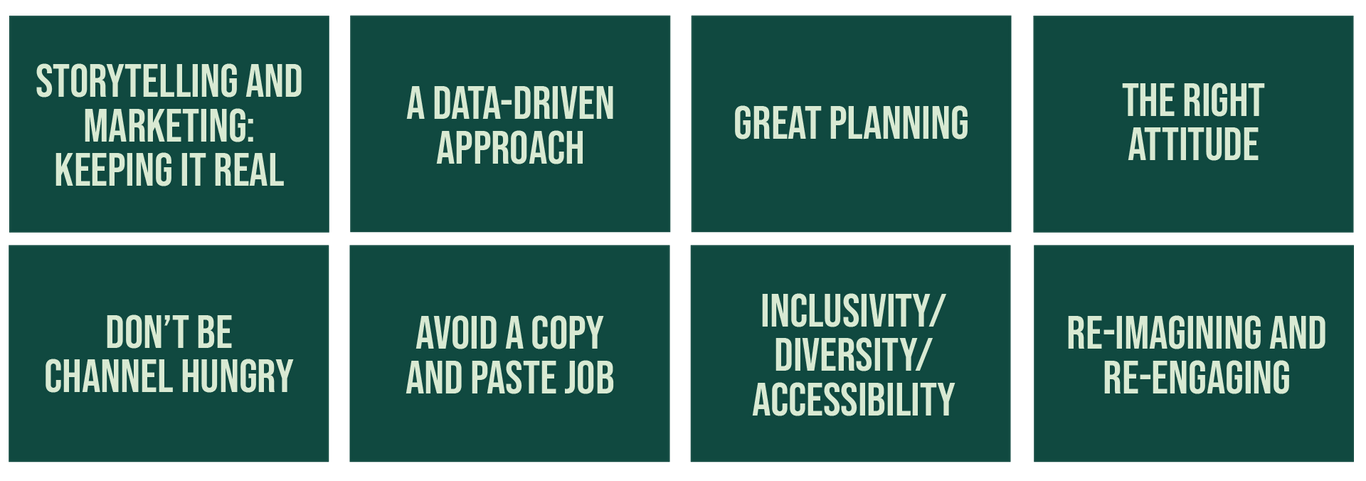Content
How important is storytelling in marketing?
09/15/22
Once upon a time doesn't apply to using storytelling in marketing – in fact, marketers need it more than ever before. It remains a fundamental human experience that unites people and drives stronger, deeper connections. But how do you master the art of storytelling to create impact? Lucy Perrott, Marketing Manager, Nordic Morning, explores the four main components of a good story and some of the industry’s biggest no-nos.
“We are, as a species, addicted to story. Even when the body goes to sleep, the mind stays up all night, telling itself stories.” ~ Jonathan Gottschall, The Storytelling Animal: How Stories Make Us Human.
Why is a good story so important?
A big part of marketing is creating well-considered top-funnel marketing content that sets your brand apart. This is an area where storytelling shines through:
- The chance to speak directly with your followers through the sharing of interesting or relatable content.
- The unparalleled opportunity to connect in a way that’s authentic, non-fluffy and non-salesy.
- Its unique ability to build a relationship through an emotional connection.
This is extremely important because not every content consumer wants to buy from you right now, but by creating a connection you are giving them “something for nothing” and keeping your brand top of mind.
Before we dig into key storytelling ingredients, let’s look at an impactful, story-driven campaign from Booking.com. This is a great example of how a simple idea brilliantly executed can drive engagement.
So what’s the winning formula for creating a story-driven campaign? It’s more straightforward than you might expect!

1. Storytelling and marketing: keeping it real
Today, storytelling in your marketing couldn’t be more accessible. With the demand for homemade authentic looking video content growing and growing (thanks TikTok!), the barrier to entry is lower than ever before. You and your marketing team can literally grab a camera and shoot. And my top tip here? Don’t overthink the content: if you choose to write, write freely as a representative of the brand and make sure it’s actionable. If you choose to film then make sure it fits your brand’s tone of voice and fits your posting channels. But above all, remember to have fun with storytelling and keep it as natural and unrehearsed as you can.
However, before you start learning the steps for a viral TikTok dance, tap into your brand’s data to make sure you know your audience and the type of content they are interested in – after all, if you’re an interior design company there’s no point recreating the latest dance number if your viewers are following you for styling tips and tricks.
2. A data-driven approach
I cannot overemphasize how important data is – make it the center of everything you do! An analytics platform feeds you with the insights you need to create buyer personas by identifying who your existing and potential customer base are.
Today we have access to a large amount of analytics, so the trick is being able to identify which data to focus on so that you don’t become overwhelmed. I advise being selective and using the data that’s most relevant to your key performance indicators (KPIs) and audience behavior. The results are what you should use to shape your marketing decisions.
Pro tip: I would recommend that if you don’t already, you begin to introduce data into every meeting you take concerning your marketing strategy. There’s little to no value in creating a marketing strategy that isn’t a) built on learnings from data and b) underpinned by data at every turn (even if your campaign didn’t work as well as you hoped).
3. Great planning
Before you start the creation process, determine what your overall objective is. I find the following questions really help teams plan for success:
Will this project or campaign fit at the top, middle or bottom of our funnel? Is it a quick-win initiative or a long-term piece of work?
Can we create everything we need within our team or do you need to outsource some parts to get the results you’re looking for?
What results ARE we looking for, and are they ambitious but realistic?
4. The right attitude
Great planning also ties in with the right attitude. If you look around at what your competition is doing too much you might get stage fright. Of course you don’t want to create like-for-like campaigns but you should generate your ideas away from the noise of the industry if you can – they are more likely to be unique, fresh and original. Approach the challenge with a blank piece of paper and then take your ideas and test them with your existing data. Ask yourself: “Would this work for our buyer persona/s?”, “Have we seen success with content like this before, and if so, what can we learn?”
5. Don’t be channel hungry
Focus! With more channels available to marketers than ever before, where should you focus your attention? It’s easy to get overwhelmed and channel hungry when you first start out with a new strategy. But my biggest tip is to ignore what everyone else is doing and instead use your brand’s data to find out where you need to have a presence.
I would save any more experimental channels for later if you can, to ensure that your hygiene channels are working to their best possible capacity. I’d say start simple and prove the business case on the channels you can manage and build from there. There’s no arguing with data, after all!
6. Avoid a copy and paste job
Some marketers have shared with me their temptation to copy and paste content from one channel to another. This is one of my biggest no-nos – it’s not a shortcut but a dead end! If you are considering sharing the same content across all channels please stop! You will find more success from being selective with what you post and where. Here’s a simple analogy to help you with this one: it’s like describing what your company does in the same way as you would to both your grandmother and someone you are trying to hire. You just wouldn’t do it, you would adjust the technical terms you use, the length of your description and probably the tone of voice you use as well.
We always start with the content you want to share (usually something hosted on your website such as a blog), then take that content and slice it per channel you think your audience should hear about it on. Make sure you adapt the length, tone and imagery accordingly. I advise you to keep the images in the same look and feel or ‘family’ but consider using a reel or a video version for social media to get the engagement you’re looking for.
7. Inclusivity/diversity/accessibility
All campaigns should go through the parameters of inclusivity. This could mean making adjustments to the way in which you write e.g. the chosen language (think local if that’s what your audience needs), and your imagery should also be diverse, featuring a wide range of people across your posts. Accessibility is also paramount: everyone should be able to effectively access your content, otherwise you are neglecting a huge part of your audience.
There are a large number of accessibility issues to consider when creating content, such as how will this content work with assistive technologies, so I encourage you to dig down deeper into this area.
8. Re-imagining and re-engaging
Lastly, here’s another great example of a brand that’s re-imagining and re-engaging their audience: Lego. The 90-year-old brand is working to ‘keep the world playing’! through its new series of advertisements.
Fun fact, LEGO is an abbreviation of ‘Leg Godt’ meaning ‘Play well’ in Danish.
And play well they do! This is the type of story-focused content that viewers want to watch again and again.
Of course, I could go on but start here and make sure you have these areas well covered! And if you're looking for expert support to get your storytelling to its best - our team is only a contact form away.



